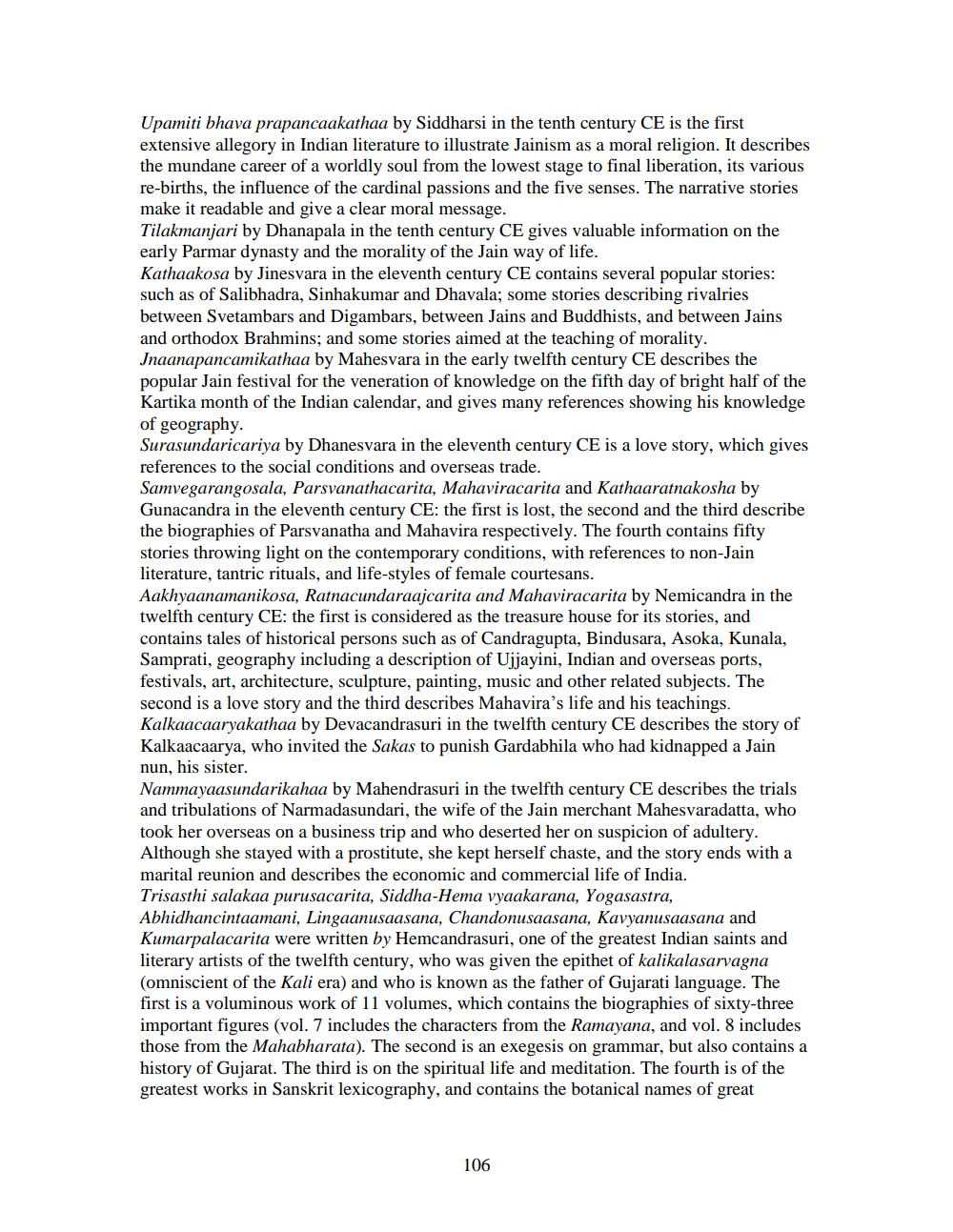________________
Upamiti bhava prapancaakathaa by Siddharsi in the tenth century CE is the first
extensive allegory in Indian literature to illustrate Jainism as a moral religion. It describes the mundane career of a worldly soul from the lowest stage to final liberation, its various re-births, the influence of the cardinal passions and the five senses. The narrative stories make it readable and give a clear moral message.
Tilakmanjari by Dhanapala in the tenth century CE gives valuable information on the early Parmar dynasty and the morality of the Jain way of life.
Kathaakosa by Jinesvara in the eleventh century CE contains several popular stories: such as of Salibhadra, Sinhakumar and Dhavala; some stories describing rivalries between Svetambars and Digambars, between Jains and Buddhists, and between Jains and orthodox Brahmins; and some stories aimed at the teaching of morality. Jnaanapancamikathaa by Mahesvara in the early twelfth century CE describes the popular Jain festival for the veneration of knowledge on the fifth day of bright half of the Kartika month of the Indian calendar, and gives many references showing his knowledge of geography.
Surasundaricariya by Dhanesvara in the eleventh century CE is a love story, which gives references to the social conditions and overseas trade.
Samvegarangosala, Parsvanathacarita, Mahaviracarita and Kathaaratnakosha by Gunacandra in the eleventh century CE: the first is lost, the second and the third describe the biographies of Parsvanatha and Mahavira respectively. The fourth contains fifty stories throwing light on the contemporary conditions, with references to non-Jain literature, tantric rituals, and life-styles of female courtesans.
Aakhyaanamanikosa, Ratnacundaraajcarita and Mahaviracarita by Nemicandra in the twelfth century CE: the first is considered as the treasure house for its stories, and contains tales of historical persons such as of Candragupta, Bindusara, Asoka, Kunala, Samprati, geography including a description of Ujjayini, Indian and overseas ports, festivals, art, architecture, sculpture, painting, music and other related subjects. The second is a love story and the third describes Mahavira's life and his teachings. Kalkaacaaryakathaa by Devacandrasuri in the twelfth century CE describes the story of Kalkaacaarya, who invited the Sakas to punish Gardabhila who had kidnapped a Jain nun, his sister.
Nammayaasundarikahaa by Mahendrasuri in the twelfth century CE describes the trials and tribulations of Narmadasundari, the wife of the Jain merchant Mahesvaradatta, who took her overseas on a business trip and who deserted her on suspicion of adultery. Although she stayed with a prostitute, she kept herself chaste, and the story ends with a marital reunion and describes the economic and commercial life of India. Trisasthi salakaa purusacarita, Siddha-Hema vyaakarana, Yogasastra, Abhidhancintaamani, Lingaanusaasana, Chandonusaasana, Kavyanusaasana and Kumarpalacarita were written by Hemcandrasuri, one of the greatest Indian saints and literary artists of the twelfth century, who was given the epithet of kalikalasarvagna (omniscient of the Kali era) and who is known as the father of Gujarati language. The first is a voluminous work of 11 volumes, which contains the biographies of sixty-three important figures (vol. 7 includes the characters from the Ramayana, and vol. 8 includes those from the Mahabharata). The second is an exegesis on grammar, but also contains a history of Gujarat. The third is on the spiritual life and meditation. The fourth is of the greatest works in Sanskrit lexicography, and contains the botanical names of great
106




